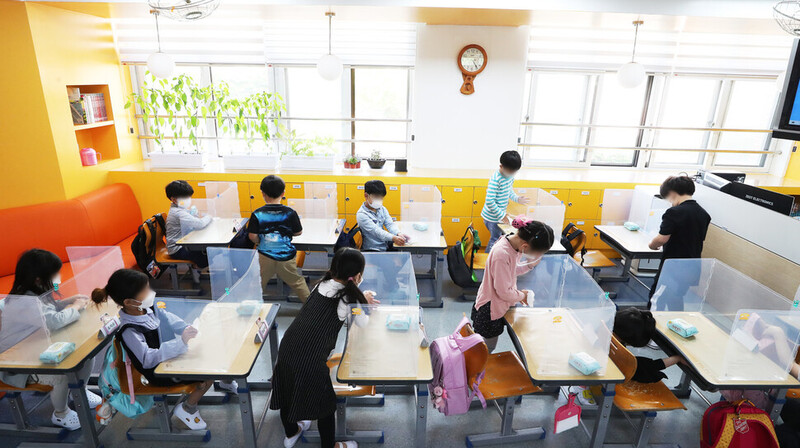Thesis co-authored by the research team of the Department of Social Medicine, Hallym University
“After school, 2.4% of confirmed cases aged 3-18 years of age in school”

At Hanil Elementary School in Suwon-si, Gyeonggi-do in May last year, when classes were held sequentially, first-year students are cleaning desks and transparent partitions with disinfecting wipes. yunhap news
In a paper recently released by the Korea Centers for Disease Control and Prevention, Jung Eun-kyung emphasized that the spread of Corona 19 was rare in schools, and pointed out that “the benefits of closing schools for the prevention of Corona 19 are limited and the personal and social damages are great.” The aim is that it is more beneficial to students and society to attend school classes under thorough quarantine. According to a paper published in the Journal of Pediatric Infectious Diseases on December 27 last year in collaboration with the research team of the Department of Social Medicine, Hallym University School of Medicine, on the 20th Years old) Of the 126 people, only 3 cases were infected through school. At the time of sequential school attendance classes, only about 2% of confirmed cases of children and adolescents spread within the school. The most common path of infection was family and relatives (59 people), followed by multi-use facilities (8 people), such as entrance examination academies, tutoring (18 people), karaoke rooms, PC rooms, and churches. The thesis analyzed that school closure did not affect the incidence of confirmed children and adolescents. A total of 13,417 domestic confirmed cases occurred during the study period, of which the proportion of confirmed cases aged 0-19 was 7.2%. There was no difference before and after school closure. The research team said, “The corona 19 infection of children and adolescents is highly likely to be related to home, entrance examination academy, private tutoring, and multi-use facilities.” It causes great damage to people.” The research team also said, “The results of this study are consistent with the results of previous studies published in Ireland, Australia, and New Zealand, saying that’schools are not a high risk environment for COVID-19 infection’. He argued that the scope should be expanded from suppressing Corona 19 through the closure of this school to achieving the school’s social values and sustainability of children’s education. In response, Park Young-joon, head of the epidemiological investigation team at the Central Defense Response Headquarters, said at a briefing that “a study was conducted to determine whether children and juveniles were infected with Corona 19, and whether it was appropriate to attend school. There weren’t many. It was possible because the quarantine measures such as preliminary inspection and early quarantine by the education and quarantine authorities were well implemented.” By Choi Ha-yan, staff reporter [email protected]
